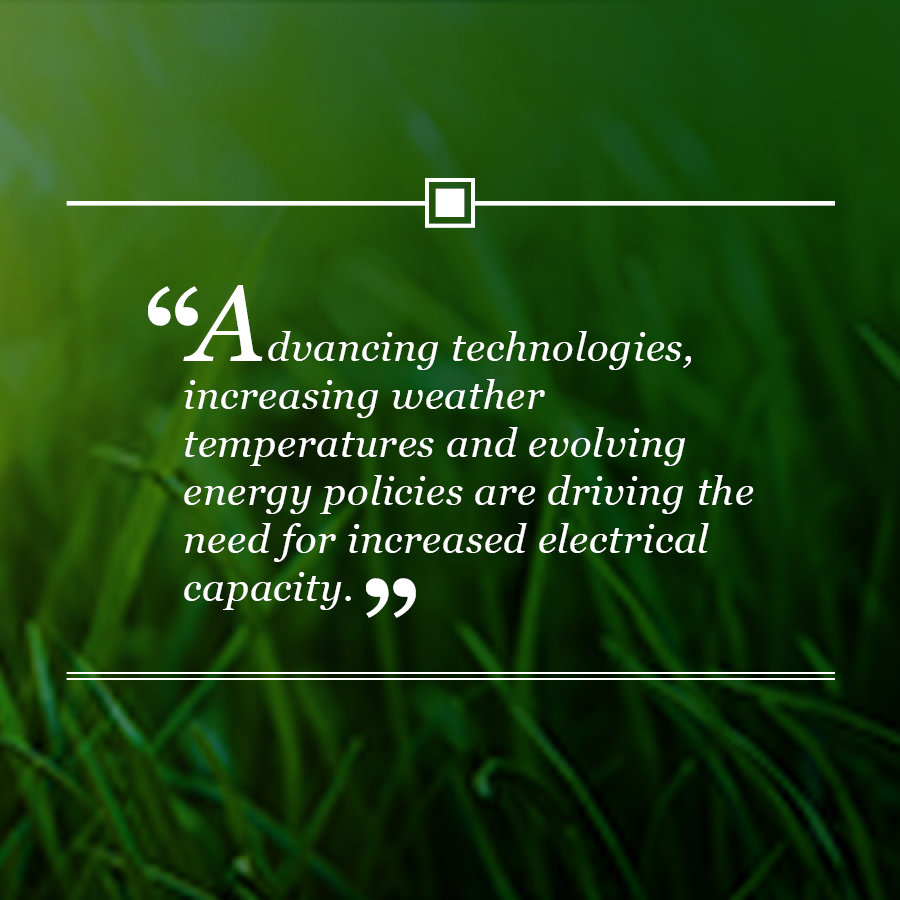
Over the past two decades, energy demand in the United States has been relatively constant, peaking at 97.4 exajoules in 2007 but decreasing to around 95.9 exajoules in 2022. However, the U.S. Energy Information Administration’s (EIA) Annual Energy Outlook 2023 projects that U.S. energy consumption could increase by up to 15% from 2022 to 2050, which has led to concern that in a period of expanded need for electricity, the country may run short of this critical commodity.
In the recent past, this amount of growth in electrical demand was not anticipated. However, advancing technologies, increasing weather temperatures and evolving energy policies are driving the need for increased electrical capacity. One example of the increasing demand involves the rapid advances in artificial intelligence (AI) and the associated expansion of data centers needed to power AI, crypto mining and our digital society. As stated in the Forbes article, “The Challenge Of Growing Electricity Demand in the US,” “Increasing interest in artificial intelligence (AI) has further amplified the growing electricity demand, with data center electricity consumption projected to escalate from 2.5% of total US consumption in 2022 to 7.5% by 2030.”
Governmental policies and associated legislation are promoting electrification through renewable energy generation and the reduction in the use of oil and natural gas. The move from transportation via vehicles with internal combustion engines to electric vehicles (EVs) will also play a role in increased electrical use. The EIA states that EVs made up approximately a 6–7% share of the U.S. vehicle market in 2022; however, the adoption of EVs is expected to increase significantly by 2050, with the purchase of electricity needed to power EVs expected to increase between 900% to 2,000% from the 2022 numbers.
Anticipated growth in the use of electricity is also due to the success of the federal CHIPS and Science Act and the Inflation Reduction Act (IRA), with the IRA accounting for more than 200 planned manufacturing facilities and spurring increased electrical demand throughout various manufacturing areas of the U.S., as reported by Forbes.

The demands noted above will drive the need for additional generating capacity and upgrades to America’s distribution grids. Over the past decade, there has been a move toward more distributed energy resources (DER), incorporating controlled and variable generating facilities, including numerous solar and wind farms, institutional combined heat and power facilities, fuel cells and small-scale photovoltaic systems. Along with the demand for additional generating capacity is the requirement to properly transmit and distribute the electricity to consumers. Besides the need to connect new DERs, much of the U.S. electrical grid was built in the 1960s and 1970s, and while there have been improvements, the grid infrastructure needs additional investment and upgrades to supply America’s power. The amount of new transmission lines installed in the United States has dropped sharply since 2013, when 4,000 miles were added, to 2022, when 670 miles of transmission lines were completed. On May 28, the White House announced the Federal-State Modern Grid Deployment Initiative, with commitments from 21 states. This program will prioritize electrical grid modernization efforts, with the target of a carbon-neutral grid by 2035.
When asked at the Bosch Connected World conference about the effect of AI on our electricity supply, Elon Musk replied, “I think we really are on the edge of probably the biggest technology revolution that has ever existed. You know, there’s supposedly a Chinese curse: ‘May you live in interesting times.’ Well, we live in the most interesting of times. For a while, it was making me a bit depressed, frankly. I was like, ‘Well, will they take over? Will we be useless?’ But the way I reconciled myself to this question was: Would I rather be alive to see the AI apocalypse or not? I’m like, I guess I’d like to see this. It’s not gonna be boring.”
The same can be said about our generation, transmission and distribution of power. Although I doubt it will lead to an apocalypse, it’s not gonna be boring. May you live in interesting times!
Bill Bradford can be reached at bbradford@hanson-inc.com.